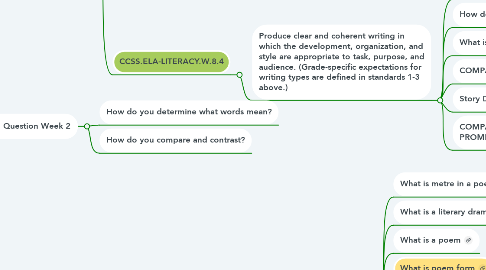
1. CCSS.ELA-LITERACY.RL.8.1
1.1. Cite the textual evidence that most strongly supports an analysis of what the text says explicitly as well as inferences drawn from the text.
1.1.1. What is the definition of cite?
1.1.2. What is does textual mean?
1.1.3. What does it mean to support?
1.1.4. What is analysis?
1.1.5. What does explicitly mean?
1.1.6. What is an inference?
2. CCSS.ELA-LITERACY.RL.8.2
2.1. Determine a theme or central idea of a text and analyze its development over the course of the text, including its relationship to the characters, setting, and plot; provide an objective summary of the text.
2.1.1. What does determine mean?
2.1.2. What is a theme or central idea?
2.1.3. What is the text?
2.1.4. What does setting mean?
2.1.5. What does plot mean?
2.1.6. What is an objective summary?
3. CCSS.ELA-LITERACY.W.8.1
3.1. Write arguments to support claims with clear reasons and relevant evidence
3.1.1. What does claim mean?
3.1.1.1. Argumentative Claims
3.1.2. What does reason mean?
3.1.3. What does relevant mean?
3.1.4. What is evidence?
4. CCSS.ELA-LITERACY.W.8.2
4.1. Write informative/explanatory texts to examine a topic and convey ideas, concepts, and information through the selection, organization, and analysis of relevant content.
4.1.1. What is informative writing
4.1.2. What does examine mean?
4.1.3. What are concepts?
4.1.4. What is explanatory writing?
5. Got a cat? Theres an app for that
6. Does lightning ever strike twice?
7. DOK 1 BASIC
8. DOK 2 INTERMEDIATE
9. DOK 3 ADVANCED
10. DOK 4 MASTERY
11. Why do we sneeze?
12. Teacher will give an example of informative writing
12.1. Student will give example of informative writing
12.1.1. Teacher will give an example of inference.
12.1.1.1. Student will give an example of inference
12.1.1.1.1. Teacher will critique the inference made
13. Week 1
14. CCSS.ELA-LITERACY.RL.8.4
14.1. Determine the meaning of words and phrases as they are used in a text, including figurative and connotative meanings; analyze the impact of specific word choices on meaning and tone, including analogies or allusions to other texts.
14.1.1. What does figurative mean?
14.1.1.1. figurative poem
14.1.1.2. figurative types
14.1.1.2.1. PERSONIFICATION
14.1.1.2.2. HYPERBOLE
14.1.1.2.3. METAPHOR
14.1.1.2.4. ALLITERATION
14.1.1.2.5. REPETITION
14.1.1.2.6. IMAGERY
14.1.2. What is connotation and tone?
14.1.3. What are analogies?
14.1.4. What are allusions?
14.1.5. What is tone?
14.1.6. What is mood?
15. CCSS.ELA-LITERACY.RL.8.5
15.1. Compare and contrast the structure of two or more texts and analyze how the differing structure of each text contributes to its meaning and style.
15.1.1. author's purpose
15.1.2. What is writing structure?
15.1.3. What is a claim
15.1.4. What is a counterclaim
15.1.5. THESIS
15.1.5.1. Author's purpose vs. thesis
15.1.6. PERSUASIVE ESSAY THESIS
15.1.7. persuasive writing prompts
15.1.8. What is bias
15.1.8.1. PORTRAIT
15.1.8.2. GLASS
15.1.8.3. PROFIT
15.1.9. LOGIC APPEAL
15.1.9.1. ETHOS APPEAL
15.1.9.2. PATHOS APPEAL
15.1.9.3. LOGOS APPEAL
15.2. CCSS.ELA-LITERACY.W.8.4
15.2.1. Produce clear and coherent writing in which the development, organization, and style are appropriate to task, purpose, and audience. (Grade-specific expectations for writing types are defined in standards 1-3 above.)
15.2.1.1. What does coherent mean?
15.2.1.2. How do you compare?
15.2.1.3. What is contrast?
15.2.1.4. COMPARE AND CONSTRAST THESIS
15.2.1.5. Story Development
15.2.1.6. COMPARE AND CONSTRAST WRITING PROMPTS
16. CCSS.ELA-LITERACY.W.8.3
16.1. Write narratives to develop real or imagined experiences or events using effective technique, relevant descriptive details, and well-structured event sequences.
16.1.1. What is a narrative?
16.1.1.1. HOW TO WRITE A NARRATIVE
16.1.1.1.1. primary audience
16.1.1.1.2. secondary audience
16.1.1.1.3. characterization
16.1.2. What are writing techniques?
16.1.3. What are descriptive details?
16.1.4. What does sequence mean?
16.1.5. Writing Narrative Prompts
16.1.5.1. 1st person
16.1.5.2. 2nd person
16.1.5.3. 3rd person
17. Essential Question week 1
17.1. What is an example of textual evidence?
17.2. What inferences can be drawn from the text?
18. Essential Question Week 2
18.1. How do you determine what words mean?
18.2. How do you compare and contrast?
19. Wow do you mummify a body? @AskSmithsonian
20. Tone vs. Mood
21. Literary Elements and Techniques | Tone and Mood | PBS LearningMedia
22. https://www.ixl.com/ela/grade-8
23. 8th grade reading & vocabulary (beta) | Khan Academy
24. Writing Categories
24.1. Descriptive
24.2. Narrative
24.3. Persuasive
24.4. Expository
25. NEARPOD
26. CCSS.ELA-LITERACY.RL.8.6
26.1. Analyze how differences in the points of view of the characters and the audience or reader (e.g., created through the use of dramatic irony) create such effects as suspense or humor.
26.1.1. Characterization
26.1.2. Mystery writing prompt
26.2. CCSS.ELA-LITERACY.W.8.5
26.2.1. With some guidance and support from peers and adults, develop and strengthen writing as needed by planning, revising, editing, rewriting, or trying a new approach, focusing on how well purpose and audience have been addressed. (Editing for conventions should demonstrate command of Language standards 1-3 up to and including grade 8 here.)
27. CCSS.ELA-LITERACY.RL.8.10
27.1. By the end of the year, read and comprehend literature, including stories, dramas, and poems, at the high end of grades 6-8 text complexity band independently and proficiently.
27.1.1. Poems
27.1.1.1. What is metre in a poem?
27.1.1.2. What is a literary drama
27.1.1.3. What is a poem
27.1.1.4. What is poem form
27.1.1.4.1. How many poem forms are there?
27.1.1.5. What is poem structure
27.1.1.5.1. Internal and external structure
27.1.1.6. What is a couplet
27.1.1.6.1. More on couplets
27.1.1.7. Poem writing prompt
27.1.1.7.1. Student options
27.1.1.8. Simple short poems
27.1.1.9. characterization
27.1.2. Dramas
27.2. CCSS.ELA-LITERACY.W.8.6
27.2.1. Use technology, including the Internet, to produce and publish writing and present the relationships between information and ideas efficiently as well as to interact and collaborate with others.

